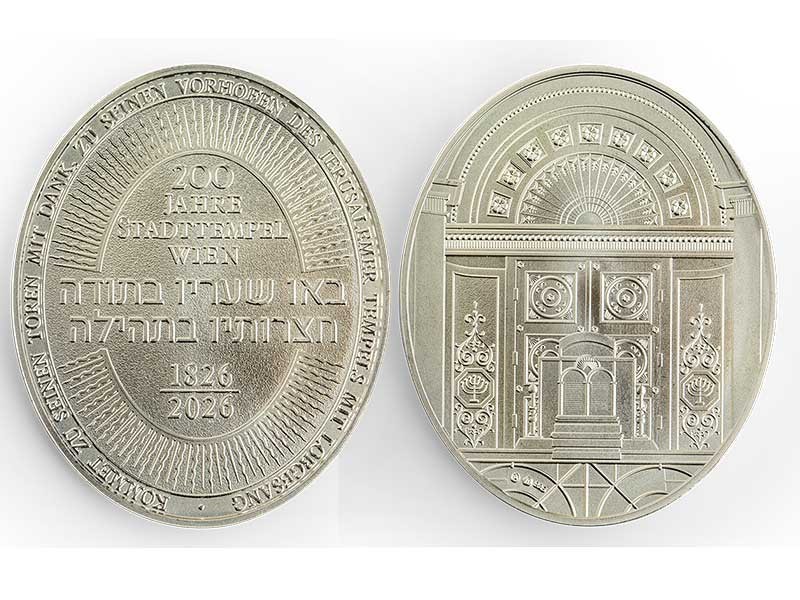To mark the 200th anniversary of Vienna’s main synagogue, Münze Österreich is issuing a commemorative medal honouring this living testament to Jewish history.
In the heart of Vienna, discreetly tucked away within the building complex at 2–4 Seitenstettengasse, a unique architectural and historical gem has stood for two centuries – the Vienna City Temple. To mark the 200th anniversary of this special place, Münze Österreich is issuing a commemorative medal in a sign of recognition and historical responsibility.
The Stadttempel was built between 1822 and 1826 to designs by the imperial architect Joseph Kornhäusel. The synagogue’s architectural ‘invisibility’ was not a coincidence but a direct consequence of the legal situation at the time, as places of worship for non-Catholic religious communities were not allowed to be recognisable as such from their exterior. For this reason, the synagogue was integrated into a residential and commercial complex between what is now Seitenstettengasse and Desider-Friedmann-Platz. Today, this place is considered the spiritual and organisational centre of the Jewish community both in Vienna and throughout Austria.

Architecturally, the Stadttempel's oval main hall is reminiscent of a traditional Viennese theatre – a symbol of the connection between tradition and modernity. Open to the diversity of Jewish life, firmly anchored in its history, but always looking ahead, the Stadttempel continues to embody this spirit to the present day.
In the November Pogrom of 1938, Jewish institutions were destroyed, homes were vandalised, shops were looted and people were abused, deported and murdered throughout the German Reich, including Austria. Within a few days, Jewish men and women were stripped of all protection under law and society and were declared outlaws.
In Vienna, almost all synagogues, prayer houses and institutions of the Jewish community were systematically destroyed. The Stadttempel survived those days of violence, however – not by chance but because of specific tactical considerations on the part of the perpetrators. The building’s close structural integration into the surrounding residential and commercial complex made it impossible to burn in a controlled manner, as the risk of the fire spreading to adjacent buildings was too great. In addition, the temple building housed the archives of the Jewish community, including the registry books that were essential to the Nazi bureaucracy’s plan to systematically register, disenfranchise, deport and ultimately exterminate Jewish people. For these reasons, the Stadttempel was spared – as the only Jewish house of prayer in Vienna.
After World War II, the synagogue was restored with limited funds. Extensive renovations followed in the 1970s and 1980s, when a community centre, a kosher restaurant and what is now the Simon Wiesenthal Institute were added to the expanded building complex. Since then, the Stadttempel has stood not only as a place of religious life, but also for education, culture and community cohesion.
Today, more than 36 years since the last construction work was carried out on the building, a comprehensive restoration is imminent. Starting in autumn 2025, the synagogue and community centre will be renovated with the support of the Federal Monuments Office – a forward-looking project. Plans include replacing damaged windows, renovating the façade, sanitary facilities, ventilation and furnishings, as well as measures to improve accessibility and safety. The aim is to restore the Stadttempel's original design to its former glory while preserving it for future generations.
The Stadttempel symbolises continuity – for Jewish life in a city that has all too often been the scene of threats against it – and for the future, which must be shaped with responsibility. The Stadttempel is therefore more than a place of prayer. It is a memorial, a symbol of survival and new beginnings – and the vibrant centre of Jewish life in Vienna.
This anniversary medal not only commemorates 200 years of history but also calls upon us to preserve and carry forward this important heritage together.